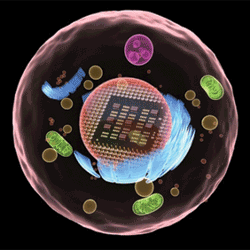MIT researcher designs electronic circuits that simulate cells for ultra-low-power and biomedical applications
In 1 s, a cell can perform about 10 million chemical reactions that require about 1 pW of power. This makes a cell much more efficient than any electronic circuit. Applying this principle, MIT’s Rahul Sarpeshkar (rahuls@mit.edu) is designing low-power, highly parallel, hybrid analog-digital electronic circuits. These circuits, he says, could be used to create ultrafast supercomputers that predict complex cell responses to drugs, or help researchers to design synthetic genetic circuits in cells.
In 2009 Sarpeshkar designed a low-power radio chip that mimics the structure of the human cochlea to separate and process cell phone, Internet, radio, and television signals more rapidly and with more energy efficiency than had been believed possible. That chip, known as the RF cochlea, is an example of “neuromorphic electronics,” a 20-year-old field founded by Carver Mead, Sarpeshkar’s thesis advisor at Caltech. Neuromorphic circuits mimic biological structures found in the nervous system, such as the cochlea, retina, and brain cells.

Electronic circuits can be made to imitate cells and could be used to create ultrafast supercomputers.
Sarpeshkar’s expansion from neuromorphic to this new field that he calls cytomorphic (cell-inspired or cell-transforming) electronics is based on his analysis of the equations that govern the dynamics of chemical reactions and the flow of electrons through analog circuits. He has found that those equations, which predict the reaction’s (or circuit’s) behavior, are astonishingly similar, even in their noise properties. He explains this and more in his book, Ultra Low Power Bioelectronics (Cambridge University Press, 2010).
Chemical reactions (for example, the formation of water from hydrogen and oxygen) only occur at a reasonable rate if enough energy is available to lower the barriers that prevent such reactions from occurring. A catalyst such as an enzyme can lower such barriers. Similarly, electrons flowing through a circuit in a transistor exploit input voltage energy to allow them to reduce the barrier for electrons to flow from the transistor’s source to the transistor’s drain. Changes in the input voltage lower the barrier and increase current flow in transistors, just as adding an enzyme to a chemical reaction speeds it up. Essentially, cells may be viewed as circuits that use molecules, ions, proteins, and DNA instead of electrons and transistors. That analogy suggests that it should be possible to build electronic chips — what Sarpeshkar calls “cellular chemical computers” — that mimic chemical reactions very efficiently and on a very fast timescale.
One potentially powerful application of such circuits is in modeling genetic network — the interplay of genes and proteins that controls a cell’s function and fate. In a paper presented at the 2009 IEEE Symposium on Biological Circuits and Systems, Sarpeshkar designed a circuit that allows any genetic network reaction to be simulated on a chip. For example, circuits can simulate the interactions between genes involved in lactose metabolism and the transcription factors that regulate their expression in bacterial cells.
In the long term, Sarpeshkar plans to develop circuits that mimic interactions within entire cellular genomes, which are important in enabling scientists to understand and treat complex diseases such as cancer and diabetes. Eventually, researchers may be able to use such chips to simulate the entire human body, he believes. Such chips would be much faster than computer simulations now, which are highly inefficient at modeling the effects of noise in the large-scale nonlinear circuits within cells. For more information, visit http://www.rle.mit.edu/avbs/default.htm or contact rahuls@mit.edu.
Paul O’Shea
Advertisement
Learn more about MIT





